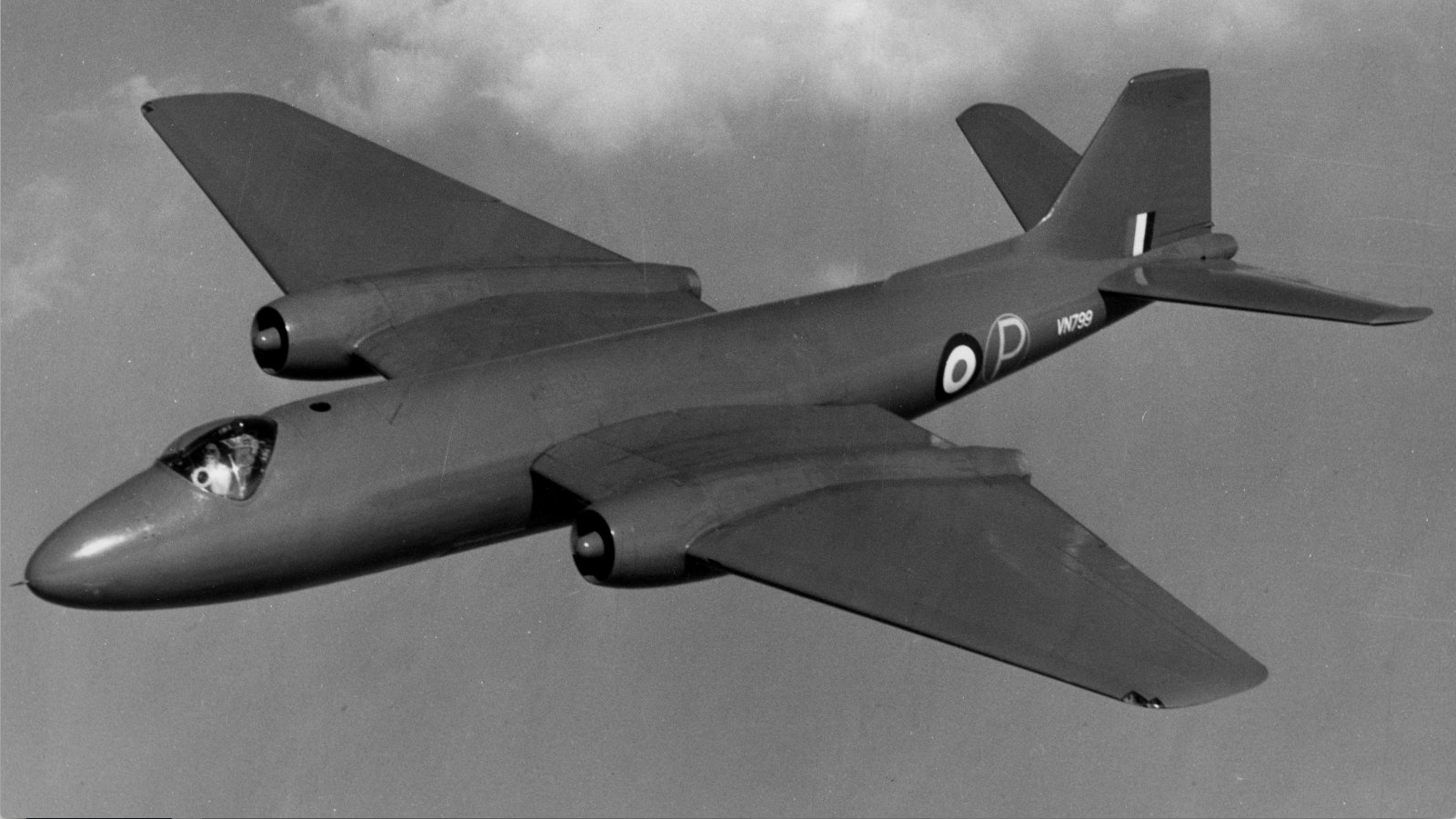

Friday, 13 May 1949: At Warton Aerodrome, Lancashire, Chief Test Pilot Roland Prosper Beamont, C.B.E., D..S.O and Bar, D.F.C. and Bar, made the first test flight of the English Electric A.1 prototype, VN799, a very high altitude light bomber powered by two turbojet engines.
VN799 was the first of four prototypes. Three were equipped with Rolls-Royce
The newly completed airplane had been rolled out 2 May, and over the next several days underwent a series of static and taxi tests. The prototype was painted overall “plate blue.”
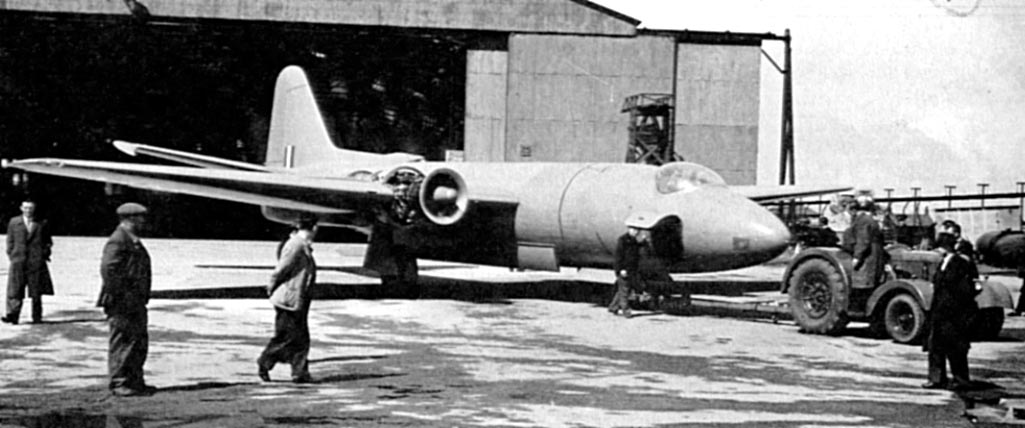

“Bee” Beamont flew the prototype for approximately one-half hour. Other than a problem in yaw, which would be corrected with minor modifications to the vertical fin and rudder over the next several test flights, the aircraft performed very well. Months earlier, the bomber had been ordered into production “off the drawing board.”
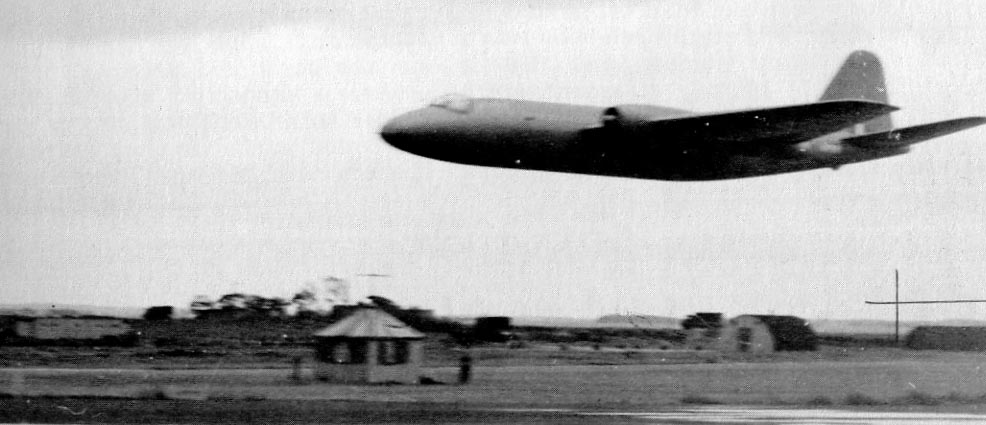
British bombers have traditionally been named for cities. Canberra, capitol of Australia, was selected as the new airplane’s name in January 1950.
 The English Electric B. Mk. I was a twin engine mid-wing bomber, operated by a pilot and navigator/bombardier. The Mk. I was 63 feet, 11 inches (19.482 meters) long, with a wing span of 66 feet, 3 inches (20.193 meters), and overall height of 15 feet, 6.9 inches. (4.747 meters). The wing used a symmetrical airfoil and had 2° angle of incidence. The inner wing had 2° dihedral, and the outer wing, 4° 21′. The total wing area was 960 square feet (89.2 square meters). The tailplane had a span of 27 feet, 4.9 inches (8.354 meters) with 1° angle of incidence and 10° dihedral. Total area of the stabilizer and elevators was 171.1 square feet (15.90 square meters).
The English Electric B. Mk. I was a twin engine mid-wing bomber, operated by a pilot and navigator/bombardier. The Mk. I was 63 feet, 11 inches (19.482 meters) long, with a wing span of 66 feet, 3 inches (20.193 meters), and overall height of 15 feet, 6.9 inches. (4.747 meters). The wing used a symmetrical airfoil and had 2° angle of incidence. The inner wing had 2° dihedral, and the outer wing, 4° 21′. The total wing area was 960 square feet (89.2 square meters). The tailplane had a span of 27 feet, 4.9 inches (8.354 meters) with 1° angle of incidence and 10° dihedral. Total area of the stabilizer and elevators was 171.1 square feet (15.90 square meters).
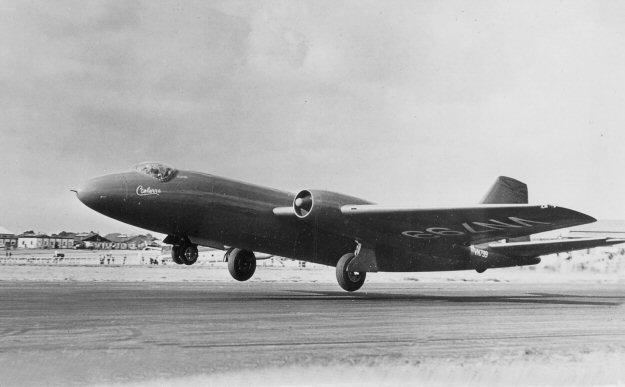
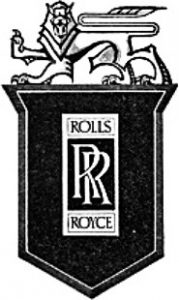 VN799 was powered by two pre-production Rolls-Royce Avon R.A.2 engines. The Avon R.A.2 was a single-spool, axial flow turbojet with a 12-stage compressor section and single-stage turbine. It was rated at 6,000 pounds of thrust (26.69 kilonewtons). It weighed 2,400 pounds (1,089 kilograms). VN799 was the first British airplane built with an axial-flow turbojet engine.
VN799 was powered by two pre-production Rolls-Royce Avon R.A.2 engines. The Avon R.A.2 was a single-spool, axial flow turbojet with a 12-stage compressor section and single-stage turbine. It was rated at 6,000 pounds of thrust (26.69 kilonewtons). It weighed 2,400 pounds (1,089 kilograms). VN799 was the first British airplane built with an axial-flow turbojet engine.
VN799, flown by Flight Lieutenant Harry Maule with Scientific Officer I Mike Burgan, crashed at Sutton Heath, near RAF Woodbridge, 18 August 1953. The engines stopped due to fuel exhaustion while testing automatic landing systems. Maule and Burgan suffered minor injuries, but the airplane was destroyed. At the time of the crash, the prototype Canberra had flown a total of 1,540 hours, 40 minutes.
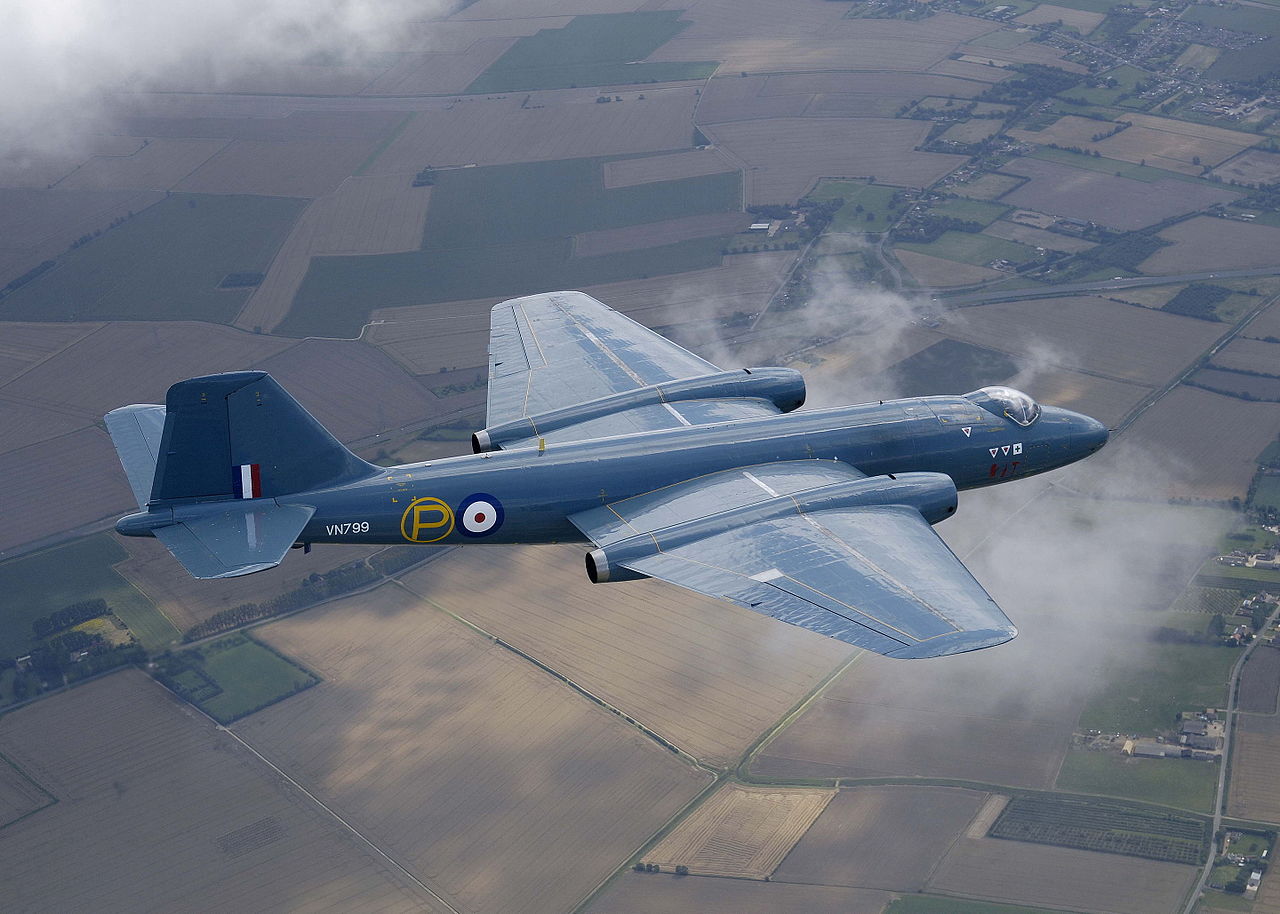
Interestingly, in October 1946, a 34-passenger civil transport variant of the Canberra was proposed, with an enlarged 10-foot-diameter fuselage.
The Canberra was produced in bomber, intruder, photo reconnaissance, electronic countermeasures and trainer variants by English Electric, Handley Page, A.V. Roe and Short and Harland. In the United States, a licensed version, the B-57A Canberra, was built by the Glenn L. Martin Company. The various versions were operated by nearly 20 nations. The Canberra was the United Kingdom’s only jet-powered bomber for four years. The last one in RAF service, a Canberra PR.9, made its final flight on 28 July 2008.
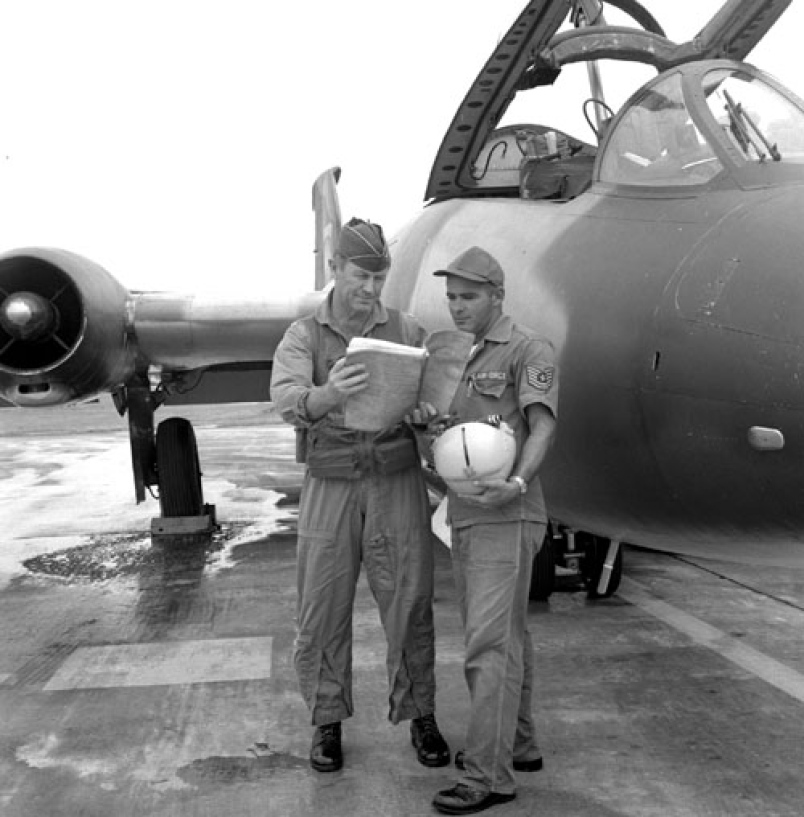
© 2019, Bryan R. Swopes
Amazing. considering there are still 3 WB-57Fs flying in the High Altitude Atmospheric Research Program at NASA. Occasionally people will ask the open ended question, “What are the most successful aircraft designs in history?” – The Canberra – out of simple longevity might deserve a place in the top 50… And for some reason it’s one of those aircraft that doesn’t get much love, and I sorta forget about.
Maybe there needs to be a list of “Sleeper Planes” – Aircraft that are very successful, but don’t get the love they deserve. “Maybe I will go on Quora.com and ask for peoples nomination.
Keep up the good work man! I am addicted to your page!
Many people are probably unaware that famed test pilot Chuck Yeager flew the Martin B-57 in combat over Southeast Asia during the Vietnam War.
Thank you, Ken. I’m glad you like it.
The Canberra had a long and interesting history. In 1957 a Canberra equipped with a rocket engine for additional high-altitude thrust set a world altitude record of 70,310ft. During the Falklands War in 1982 the Argentine Air Force used Canberras against the British task force, with one shot down by a missile from HMS Cardiff and another by a Sea Harrier.
Although the Canberra was originally designed as a high altitude bomber it was later used as a low altitude strike aircraft tasked with delivering tactical nuclear weapons against Soviet forces in Europe. Crews would be trained to carry out lob-bombing attacks, approaching the target at 250ft altitude and 434kts before pulling up sharply and releasing the nuke to “lob” it towards the target while the aircraft turned away. However, if there was no nearby landmark that could be used to mark the release point or if the crew missed it, they would be expected to fly over the target and then release the bomb while the Canberra was pulling up through the vertical. The bomb would ascend almost vertically to about 10,000ft and then drop back down on the target while the aircraft continued through a half-loop and tried to flee the blast zone in time (source: the book “A Bucket of Sunshine” by Mike Brooke, which describes the author’s experiences on a Canberra squadron in the 1960s).
Yep. Still flying. One flew past just a couple hours ago (NASA / EFD). These have a lot of modifications. The engines make a distinctive high pitched whine.
They flew combat missions into the late 70s in the Rhodesian Bush War.
I sat in one once. 1962.
One still flying at Temora Australia
I flew the T17 from 1987 to 1989.
It was a pig to fly asymmetrically and would kill you very quickly if you got it wrong. In my time flying it, two aircraft crashed, one during asymmetric practice and one after an engine failure on approach in IMC. Three Pilots and a Navigator died.
The T17 was a heavily modified B2 with the bomb bay welded shut and filled with jamming gear which could get very hot. Not ideal with the fuel tanks sitting above them. All our T17’s were older than me and they were all slightly bent in different ways!
I watched the B57 during a tour in Vietnam and was very impressed. A technical question: How is the wing structure carried through the engines on each side? It must be over and under the engine nacelle?
The wing has a single spar which passes through the fuselage. The engine nacelles are mounted with tubular trusses. TDiA’s primary research source, which would have undoubtedly answered your question in much greater detail, and no doubt with excellent illustrations, the archives of “Flight,” a biweekly publication which originated in 1908, dropped off the Internet in 2019 when Flight International changed its computer system. FI has stated that they were working to make the archives available once again, many years have passed without that happening.